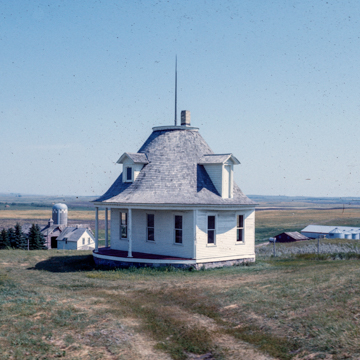Warren Hurd was a farmer, merchant, banker, and realtor in Superior, Iowa. Spurred on by the success of bonanza wheat farms in eastern North Dakota, settlers and speculators, including Hurd, brought a boom to Wells County. The building was Hurd’s sales transaction office, located on a ranch that he operated, although he continued to make his permanent home in St. Paul, Minnesota. Prospective land buyers were driven out to the Round House by surrey or spring wagon from Bowdon, the nearest railroad station, and were boarded at the nearby ranch house. Visitors usually stayed for several days to inspect tracts available for purchase or homestead entry. When the Round House was used as a land office, buyers would climb to the second story to view the countryside through telescopes from the dormers. Sales were concluded over drinks and cards in the reception room. The building, which also included two office spaces, continued in use as a land office until 1909.
Located high on the eastern slope of a hillside, the Round House was designed and built by Hurd’s brother Elgin, a carpenter and stonemason, who had also studied architecture. The one-and-a-half-story building is not actually round in plan, but derives its name from the circular roof supported by six columns upon a nearly circular porch floor and cut-stone foundation. The flagpole on the circular deck at the top of the roof was raised with the building. Four gabled dormers pierce the roof slopes, three of which contain windows and the other, on the west, originally contained a vertical-board door giving access to the upper story by way of an outside stairway (since removed). In the 1960s, the Wells County Historical Society rescued this intriguing feature of local land speculation from demolition.











